Are you addicted to Spain as much as I am? It goes without saying that this country has a fascinating history, which resulted in dozens of famous Spanish landmarks everyone should add to their bucket list.
From Roman ruins to palaces from the eras of the Moors and the Reconquista to unusual modernist buildings, here’s the most wanderlust-fueling list of famous monuments in Spain.
*This post may contain affiliate links from which I earn a commission (for more info, read my disclosure). As an Amazon Associate, I earn from qualifying purchases.
*I try to keep the information on this blog as updated as possible, but I still recommend consulting the latest prices, opening hours, and other details on the official website of each site, hotel, and tour, as well as checking the updated public transport routes and timetables.

Famous Spanish Landmarks: Palaces and Castles
Royal Palace, Madrid
Wouldn’t you want to visit the home of many Spanish kings and a true Baroque architectural masterpiece?
Even though the current royal family doesn’t live there, Madrid’s Royal Palace is still their official residence and is considered the largest functioning palace in Europe.
Spreading across 135,000 square meters (1,450,000 sq ft) and containing more than 3000 exquisitely decorated rooms (though only some of them are open to the public), you simply cannot miss out on the opportunity to explore this impressive Spanish landmark.
Since the daily visits to the palace are limited, it’s important to get your ticket in advance or book a guided tour.

Alhambra, Granada
It’s not for nothing that the Alhambra is Andalucia’s most visited UNESCO World Heritage Site and the top landmark that appears on any Granada guide.
This palace and fortress complex, built in the 9th-12th centuries by the Moors and taken over later by the Spanish monarchs, is one of the most stunning and fascinating pieces of history you’ll ever see.
From its royal palaces to its courtyards to the Generalife gardens, every little corner is full of intricate details, and you could easily spend hours here.
Though a guided tour is relatively short because the Alhambra is huge, it’s still a fantastic way to learn about it, but you can also get your ticket and explore it on your own.
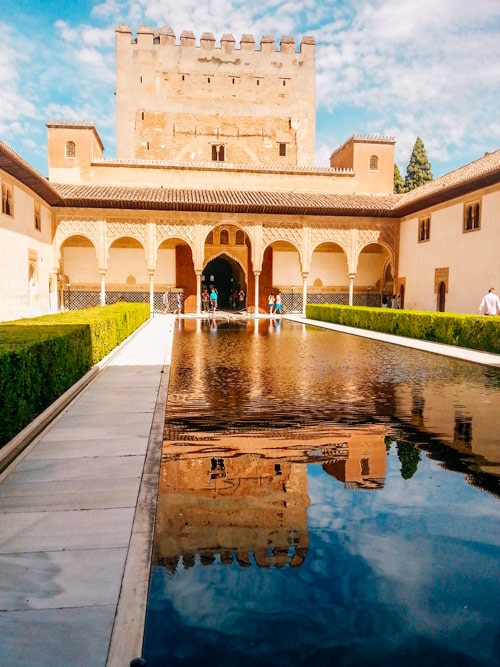
Alcazar of Seville
Another jaw-dropping UNESCO-listed royal palace complex you must visit in Andalucia is Seville’s Alcazar
Consisting of buildings from different medieval eras (Moorish & Catholic), you’ll notice some similarities to the Alhambra alongside Christian architectural styles, which were added for the Spanish monarchs.
Take your time and stroll through the alcazar’s gorgeous gardens, patios, and rooms.
You can purchase a regular ticket, but consider booking a guided tour to learn more about this place, which is one of the most famous monuments in Spain.

Colomares Castle
By Cristina from My Little World of Travelling
Castillo de Colomares, located in Benalmadena, in the province of Málaga, is a beautiful landmark in the shape of a castle.
The famous Spanish monument was built to celebrate the life and adventures of Christopher Columbus.
When you visit the castle, you will immerse yourself in the history of how a new world – called America – was discovered. As you go through the different areas of the castle, you will uncover the story behind it.
When visiting Colomares Castle, you may also want to check out the beautiful streets in the old town and the Stupa of Enlightenment Benalmádena, which has a lookout point with views of the seaside.
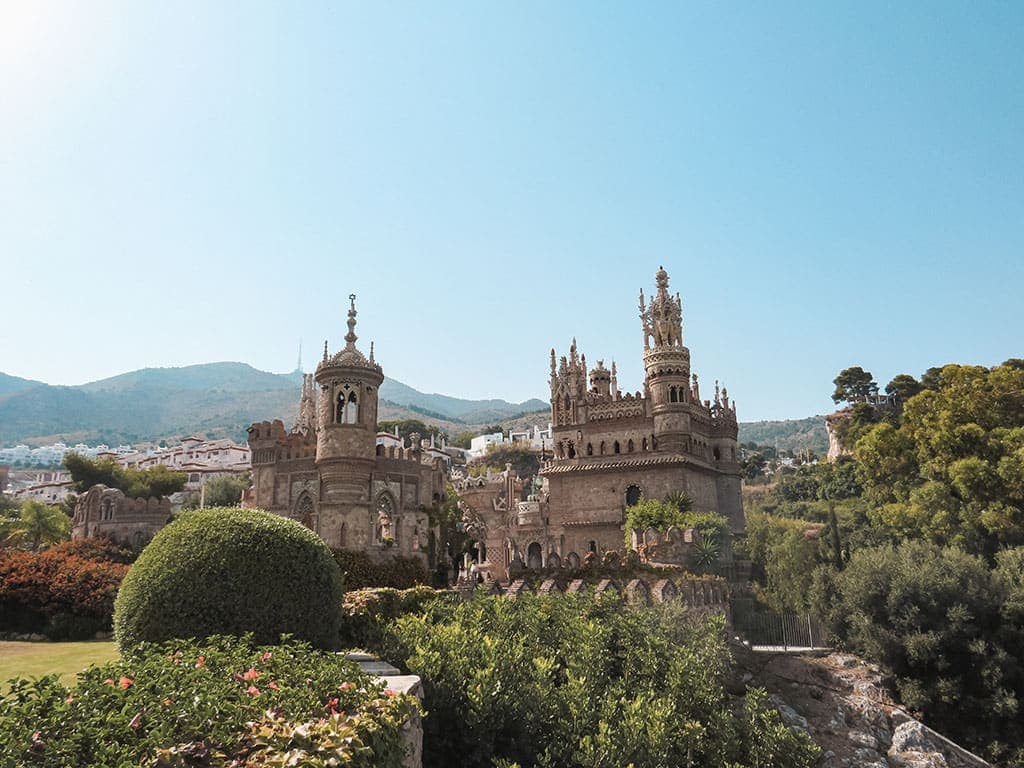
Alcazar de Los Reyes Cristianos, Cordoba
By Melissa from Parenthood and Passports
The Alcazar of the Christian Monarchs, or Alcázar de los Reyes Cristianos in Spanish, is a significant cultural landmark in Spain. The alcazar, along with the historic center of Cordoba, was designated a UNESCO World Heritage Site in 1994.
This former medieval fortress dates back to the 1300s. It is one of the most beautiful and historical places in the city and should definitely be included in any Cordoba itinerary.
The Alcazar originally served as one of the primary residences for the Spanish royal family. In fact, it was at the Alcazar of Cordoba that King Ferdinand and Queen Isabella met with the famous explorer, Christopher Columbus, to commission his voyage to the Americas.
With immaculate gardens, courtyards, castle-like towers, grand halls, and royal baths, there is a lot to see at the Alcazar complex.
Although it no longer serves as a royal palace, it remains one of the top tourist attractions in Cordoba. To learn more about it, book a guided tour.

Alcazar of Toledo
When you search for photos of Toledo, the first thing that pops up is the picture-perfect Alcazar, an impressive fortification sitting on the highest hill in the city.
Surprisingly, its history traces all the way back to Roman times when it served as a palace, but it was restored in the 16th century, and today, it houses the Army Museum and the Library of Castilla-La Mancha.
Alcazar of Segovia
A must-see Spanish landmark in Segovia’s city center is the Alcazar, a stunning medieval castle/fortress.
Fun fact about it – along with the Neuschwanstein Castle in Germany, it inspired Walt Disney’s design of the Cinderella castle (yep, the one you can find in every Disney park).
When looking back at its history, it’s not all fairytale because, in addition to serving as a royal palace, it was also a state prison and a military academy.
But thankfully, now you’re rewarded with the privilege of wandering through this majestic place, exploring its rooms, and enjoying the picturesque views surrounding it.

Palace of the Kings of Navarre of Olite
There’s nothing more magical than fairytale castles, and this medieval castle-palace has to be one of the dreamiest spots in Spain.
Built in the 13th century, it was one of the seats of the Court of the Kingdom of Navarre, and today, it consists of three different parts.
The first one is the Old Palace, now a Parador (a historic building turned into a luxury hotel) that you can book to enjoy a unique experience, and the second one is Santa María la Real church.
Last but not least is the New Palace, the most extensive area open to the public, where you can drool over the fairytale-like towers and feast on the surrounding views.

Xativa Castle
By Emma from Emma’s Roadmap
If you’re ever in the Valencian Community region or specifically visiting the city of Valencia, a perfect day trip is exploring the ancient Castle of Xativa. This village is known for its beautiful castle high upon a hill overlooking the entire region.
If you have the courage to climb up this hill, you can walk around between the almost 1000 years old walls and discover the 2 parts of the castle, el castell menor and el castell major.
The whole castle is a discovery on its own, and you can spend several hours here! Don’t worry if you don’t dispose of a car, because you can easily reach Xativa by train from Valencia.

Royal Palace of la Granja de San Ildefonso
A 20-minute drive from the city of Segovia will take you to the 18th-century Baroque-style Royal Palace of La Granja de San Ildefonso, which was the summer residence of the Spanish monarchs.
With its French-style gardens and gorgeous monumental fountains, it’s often said that the luxurious complex was inspired by Versailles. The fountains only operate on specific dates between April and August (see the schedule at the bottom of the page), so plan your visit accordingly.
In July, August, and September, the town also hosts a festival called Noches Mágicas de La Granja (Magical Nights of La Granja), which includes live music shows, dance performances, and more.

Alcazaba of Malaga
By Disha from Disha Discovers
One of the most beautiful and important landmarks in Spain is the Alcazaba of Malaga. Built on Gibralfaro Mountain right in the city center, it’s a palatial fortification that was constructed in the early 11th century by the Hammudid dynasty.
It went through its first major siege in 1487. Eventually, the fortress was used as a prison, hospital, and more until the 1930s. Then, it became a major historical site in Spain.
Today, the Alcazaba of Malaga is one of the most prominent Muslim architectural pieces in Spain. It’s a must-visit because it’s the most preserved Alcazaba in Spain, where you’ll also see the remains of a Roman theatre.
Plus, you’ll see gorgeous panoramic views of the city and the sea from the fortress walls. When visiting, be sure to set aside 1-2 hours to fully explore the fortress or book a guided tour.
If you’re visiting in the spring, look out for the beautiful flowers.

Gibralfaro Castle, Malaga
By Ali from Travel Made Simple
One of the attractions you should definitely include on your Malaga itinerary is the Gibralfaro Castle. This castle sits on top of a hill and overlooks the city, so it’s a great place for views.
It was built in the 14th century to protect the nearby Alcazaba, and even though much of it is in ruins today, it’s still very impressive.
You can walk along the walls to see the castle and Malaga from different angles. It’s also worth checking out the castle’s courtyard and visiting the Interpretation Center, a small museum where you can learn about its history.
It’s a steep uphill climb but worth every step. If you visit the Alcazaba on the same day, get the combo ticket for a discount.

Palacio de la Magdalena, Santander
By Kirstie from Kirstie Will Travel
The Palacio de la Magdalena is Santander’s Royal Palace that sits on the eastern peninsula of the city, looking out to the Bay of Biscay and the Bay of Santander on either side.
It was built in the early 1900s as a summer residence for the Spanish Royal family as Santander was, and continues to be, a popular destination to escape the summer heat of the central and southern Spanish cities.
The palace was retired as the Royal family’s summer residence a few decades later and now belongs to the city of Santander.
You can tour the grand interior for a small fee. It’s also worth exploring the gardens of the Magdalena Peninsula that surround the palace.
Between the rugged landscape, with cliffs and beaches, an open-air marine park, and a small open-air museum dedicated to a famous Cantabrian explorer, you could easily spend half a day taking in everything this place has to offer.

Aljafería Palace, Zaragoza
Although many Moorish palaces and castles in Spain are located in Andalucia, some are scattered in other regions, like the fortified Aljaferia Palace, which is found in Aragon’s capital city, Zaragoza.
Built in the 11th century for the Arab kings, it is considered one of the most luxurious and best-preserved palaces from the era of the taifas, which were independent Moorish kingdoms.
Later on, it was also the royal residence of the kings of the Kingdom of Aragón, but its exquisite architecture is undeniably Moorish, making it a one-of-a-kind spot in the city.

Royal Palace of Aranjuez
By Paulina from Paulina on the Road
Situated in a low-lying meadow in Spain, this palace was declared a World Heritage Site by UNESCO in December 2001.
For years, many kings and queens have ruled Aranjuez. Philip II passed an order in 1561 to replace the Aranjuez Palace with a plan drafted by his father, Emperor Charles V.
In 1715, Philip V continued the construction of the building, which is now the main body of the palace.
You must visit this landmark as it gives an opportunity to explore the combined decor of Rococo, Chinese, Elizabethan, and Moorish motifs.
The gardens surrounding the palace also keep the visitors intrigued by its beauty, like the popular Jardin del Parterre which offers great views of abundant flowers.
You can stay in the best neighborhoods of Madrid, like Malasaña, to have a wonderful trip that includes a day trip to Aranjuez.

Alcazaba of Almeria
By Paulina from Paulina on the Road
There are many reasons to visit the Alcazaba of Almeria. First and foremost, it is the second biggest Moorish fortress in Andalusia, and it offers astonishing views of the city and the coast. The structures and gardens of the Alcazaba tell everything about the history of Andalusia.
The fortress was built by the Arabs in the 10th century on a Phoenician fortification that was taken over by the Romans. Then, it was conquered by the Catholics, who took over the fortress to use it as the royal residence.
The Alcazaba is a must-visit because the gardens and top of the wall offer scenic views, a warm ocean breeze, and a sense of the history of Andalusia.
It is among the best things to do in Almeria as you can see fountains and ponds along with low hedges and small trees. Book your guided tour here.

Crystal Palace, Madrid
While it’s not what comes to mind when thinking of a palace, the Crystal Palace is definitely a unique spot in Madrid (one of my favorites), located in the lovely UNESCO-listed Retiro Park.
It was originally built in the late 19th century as a greenhouse, and today, it belongs to the Reina Sofia Museum. Being made of glass plates and cast iron, this structure boasts a type of charm you wouldn’t find anywhere else.

Read more about Madrid:
- Landmarks in Madrid
- 2 days in Madrid
- 4 days in Madrid
- Madrid travel tips
- Where to stay in Madrid
- Museums to visit for free in Madrid
- Madrid packing list
- Breakfast and brunch in Madrid
- Fun facts about Madrid
- Is Madrid worth visiting
- Things to do in Alcala de Henares, a day trip from Madrid
These castles and palaces also make Spain a perfect girls’ trip destination!
Most Famous Landmarks of Spain: Monasteries and Cathedrals
Sagrada Familia, Barcelona
A list of the most famous sites in Spain would not be complete without Antoni Gaudi’s yet-to-be-finished masterpiece, the Sagrada Familia basilica.
Even though it has become a major tourist attraction, its striking beauty is undeniable, and it must be on your Barcelona itinerary.
Its construction actually began in the late 19th century under another architect, but Gaudi was the one who transformed it into the UNESCO-listed work of art people from around the world flock to see.
To skip the lines, get your ticket in advance or book a guided tour.
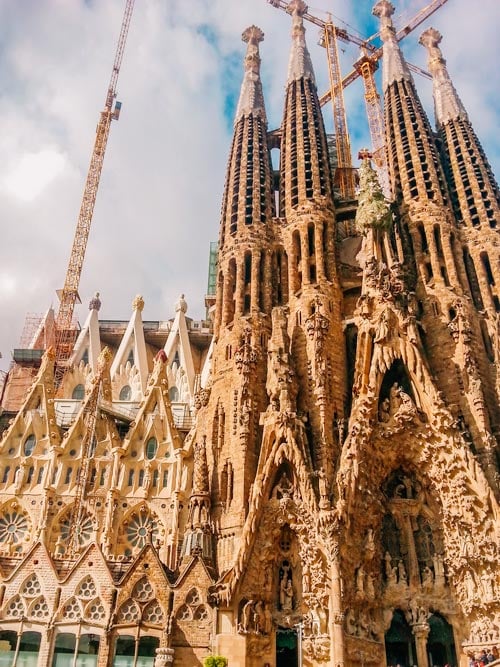
Toledo Cathedral
Commissioned by Ferdinand III of Castile (also known as the Saint), the Toledo Cathedral is considered one of the finest examples of Gothic architecture in Spain.
It’s also known for its impressive interiors, including magnificent stained-glass windows, an intricately-detailed and artistic altarpiece in the main chapel, and framed paintings by El Greco, Goya, and others.
This cathedral is seen as a true work of art, making it a must-visit landmark in Spain.
Segovia Cathedral
Not only is the Segovia Cathedral the last Gothic cathedral to be built in Spain (in the 16th century), but also one of several monuments that make Segovia’s city center a UNESCO Site.
Apart from visiting its 20+ chapels, cloister, and museum, you should admire this massive cathedral from different spots around the city, including Plaza Mayor and Torre de Juan II of the Alcazar of Segovia. Get your entrance ticket in advance here.

Cathedral-Basilica of Our Lady of the Pillar, Zaragoza
By Roxanne from Far Away Worlds
The beautiful Cathedral-Basilica of the Lady of the Pillar in Zaragoza is perhaps one of the most underrated historical landmarks in Spain.
The cathedral was the first church dedicated to the Virgin Mary and was built on the spot where the Virgin Mary appeared to Saint James, in 40 AD.
Now, almost 2,000 years later, the cathedral towers over the city of Zaragoza and is a must-see on any trip through Northern Spain. When you visit the church, you’ll find a large collection of art and sculpture.
You can also take the elevator to the top of the tower, where you’ll find extraordinary views of the city.
Inside the church, you can also see two of the three bombs which were dropped on the church during the Spanish Civil War in 1936 – and didn’t explode.

Montserrat Monastery
A must-take day trip from Barcelona, the mountainous Montserrat Monastery (try to say that fast 10 times in a row) has such an unexpected location that visiting it is quite an experience.
Perched on the mountain of Montserrat, it was founded in the early 11th century, and it still functions today with around 80 monks.
Apart from its extremely scenic surroundings, it also prides itself on housing a famous statue of the Black Madonna and having one of the oldest boys’ choirs in Europe.
To get to this wonderful place, you can take the train & cable car from Barcelona, rent a car, or book a guided day tour from Barcelona. When you arrive, if you feel like trying something more active, you can also go hiking in Montserrat.
Mosque-Cathedral of Cordoba
Did you know that Cordoba is the only city in the world with four UNESCO World Heritage Sites? One of them is the unique Mosque-Cathedral, a 16th-century cathedral built inside an 8th-century mosque.
I dare you to stay indifferent to its iconic striped double-tiered arches, though it’s packed with plenty of intricate architectural details that make it a true work of art.
To learn more about it, visit the Mosque-Cathedral of Cordoba with a guide.

Santiago de Compostela Cathedral
Every cathedral in Spain has its own story and unique features, but it’s hard to beat the significance of Santiago de Compostela Cathedral, the endpoint of the world-famous pilgrimage route – Camino de Santiago. Dating back to the 11th century, it is supposedly the burial place of Saint James the Great.
Though nowadays it seems that most people walk the Camino for the experience and not necessarily for its religious meaning, the cathedral is still a great spot to finish such a journey. You can also visit the cathedral with a guide.
New Cathedral of Salamanca
By Tom from Travel Past 50
The “New” Cathedral of Salamanca is, as the name suggests, one of the newer massive cathedrals of Spain. Building began in the early 1500s, but it was not consecrated until 1733, over 200 years later.
The construction started in late Gothic style, with all the linear turrets and flourishes, but finished up as more of a Baroque exercise. So, that means the outside, except for the dome, is more in tune with the adjacent Old Cathedral while the interior is full-on decorous Baroque.
The “New” in the name also distinguishes it from the “Old” cathedral. Unlike in most Spanish cities, the Old Cathedral was preserved when the new one was built, and it is also well worth a visit.
Salamanca is an easy day trip from Madrid – only a little more than an hour and a half by train.
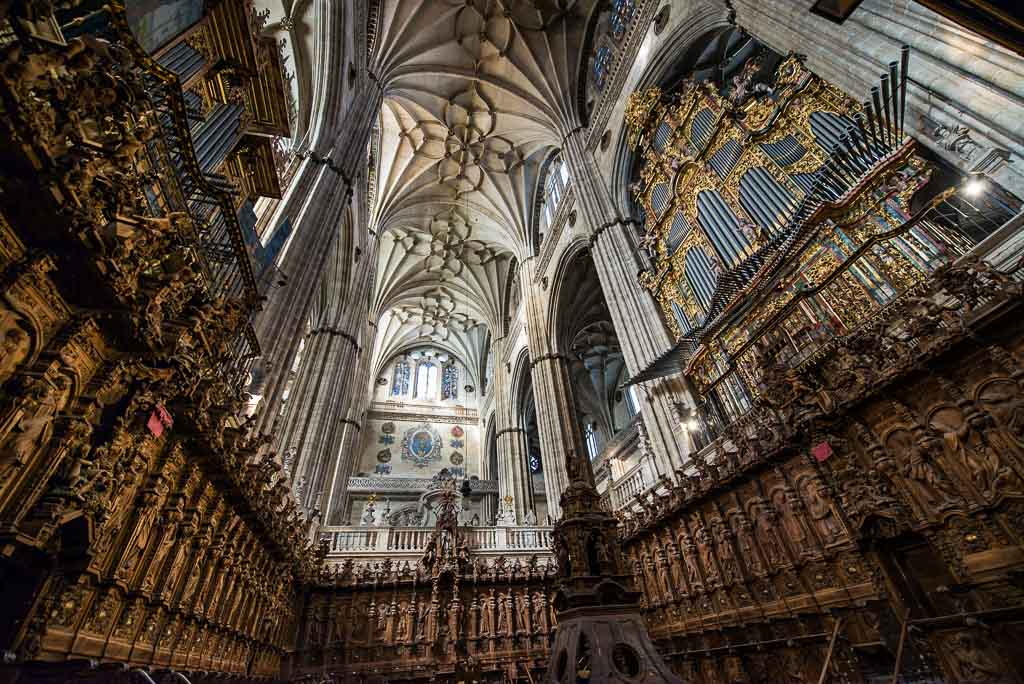
Seville Cathedral
I can still remember passing the corner of a street and being completely speechless when Seville’s cathedral, the largest Gothic temple in the world, was right there in front of me.
Built on the site of an old Muslim mosque in the 15th-16th centuries, this impressive cathedral also has a famous 12th-century bell tower, La Giralda, which was the tallest structure in the world at that time.
Don’t miss out on exploring it with a guide and book a tour or get your ticket to visit it on your own.
Almudena Cathedral, Madrid
Located right next to the Royal Palace, the stunning Almudena Cathedral is the most important religious building in Madrid. Boasting a mix of architectural styles that make it so photogenic, the cathedral took over 100 years and 6 architects to build.
You can also visit two more spaces – the crypt (free) and a small museum (€6) that grants you access to the cathedral’s dome, which offers scenic views over the palace.
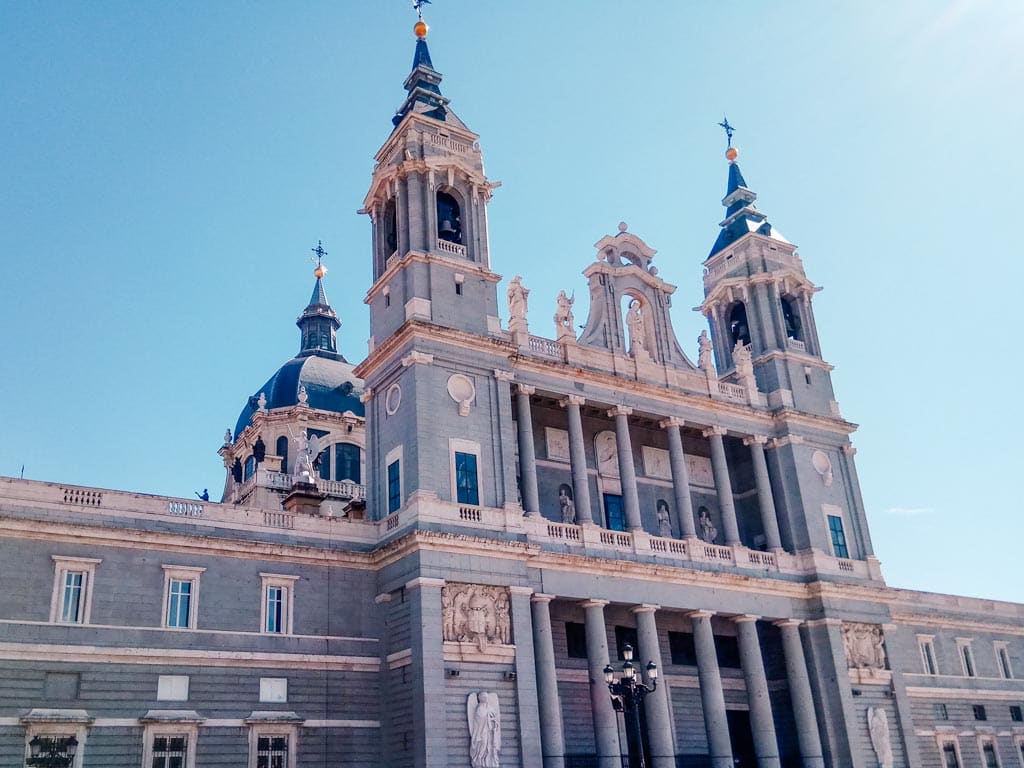
Burgos Cathedral
By Alya from Stingy Nomads
The Cathedral of Saint Mary of Burgos is one of the finest Gothic cathedrals in Europe. Its towers dominate the historical center of the capital city of Castile and León.
The construction of the cathedral started in 1221 and took 200 years to complete. Over the following centuries, it was redecorated and embellished.
The exterior of the cathedral is truly impressive. One can spend hours admiring its highly elaborated facades, portals, and towers decorated with columns, reliefs, sculptures, and rosettes.
The interior of the cathedral is just as stunning as the exterior; marble columns, the golden altarpiece with figures of saints, large stained-glass windows, multiple oil paintings, and sculptures.
To really appreciate the beauty of the interior one should visit the cathedral on a sunny day.
In 1984 the Cathedral of Burgos was declared a UNESCO World Heritage Site. It is the only Spanish church that was added to the list independently and not as a part of the historical center.

Royal Monastery of Santa María de Guadalupe
I’m not sure how much you know about the Spanish region of Extremadura, but one of the top places to see there is the UNESCO-listed Royal Monastery of Santa María of Guadalupe.
A few interesting facts about it:
- It was built on the site where a statue of Mary was discovered.
- It was declared a royal sanctuary when King Alfonso XI believed the statue had helped him win a battle.
- It was the first place Christopher Columbus visited to thank God for discovering America.
It’s a significant historical monument, but at the same time, it’s a hidden gem in Spain for international travelers, so you know it has to be on your bucket list.
San Juan de Gaztelugatxe
A must-visit place in northern Spain sitting on the Bay of Biscay, you might know San Juan de Gaztelugatxe as Dragonstone from Game of Thrones.
This small islet, which houses a 10th-century hermitage, is connected to the mainland by a man-made bridge and a narrow path of over 200 steps.
Don’t just look at it from above from the parking lot area, and make the effort to go all the way to the islet to enjoy magnificent views of the coast.

Cadiz Cathedral
Europe’s oldest city, Cadiz, deserves to be on everyone’s Andalucia road trip itinerary. And if there’s one place you shouldn’t miss there, it’s the cathedral.
Although it’s not as old as Cadiz, it’s one of the top sights in the city, built in the 18th-19th centuries over more than 115 years.
Leon Cathedral
By Frank from Mapping Spain
If you have the opportunity, visit one of Spain’s most beautiful cathedrals: Leon Cathedral (officially Santa María de León Cathedral).
The cathedral was built in Gothic style between 1205 and 1301 and was inspired by the Reims Cathedral (France). It is a huge cathedral – but what it’s most famous for is its stained glass.
It covers 1800 meters of surface, and most of it is still original to when the cathedral was constructed. Because of the stained glass, the cathedral has been nicknamed the “House of Light”. It is stunning, and it alone makes a visit to Leon worthwhile.

Palma de Mallorca Cathedral
By Stephanie from History Fangirl
The beautiful Palma de Mallorca Cathedral is the seat of the bishopric of Mallorca. The first stone of the cathedral was laid down in 1229, but construction lasted until the 1600s.
The current Palma Cathedral is the third cathedral on this site. It is Gothic in style and has one of the tallest bell towers in Spain at 105 meters tall.
The building is most famous amongst people less familiar with Mallorca because of its association with Antoni Gaudi. Better known for his works in places like Barcelona, he came to Mallorca at the beginning of the 20th century to work on the cathedral’s restoration.
Artistic differences lead to Gaudi’s abrupt departure from the project, but you can still see his influence on the interior of the cathedral today.
The cathedral sits overlooking the Parc de la Mar and the Mediterranean Sea. A stop here can last from thirty minutes to an hour.
Get your ticket here, and don’t skip the gift shop, which has some lovely pieces that you can’t find anywhere else on the island.

Read more on Mallorca:
- Cafes for breakfast and brunch in Palma de Mallorca
- Free things to do in Palma de Mallorca
- Hidden gems in Mallorca
- A week in Mallorca
- Reasons to visit Mallorca
- What to pack for Mallorca
Royal Monastery of San Lorenzo de El Escorial
A popular day trip from Madrid, El Escorial is a 16th-century building complex that functioned as both a Spanish royal palace and a monastery. It’s also the largest Renaissance building in the world, which makes it one of a kind.
The king who commissioned it was Philip II, who wanted to have a palace, a monastery, and a burial place for his father, all in the same place. It resulted in a luxurious 33,327-square-meter complex that more than half a million people flock to see each year.
You can easily spend half a day here, strolling through El Escorial’s beautiful gardens and admiring some of its most notable rooms.
These include the library and its exquisite frescoes, the Hall of Battles and its elaborate wall paintings, and the basilica. You can get there by train or book a half-day tour from Madrid.
Valencia Cathedral
The 13th-century Valencia Cathedral might seem like just another old cathedral at first sight, but one of the things that make it unique is that many people believe it houses the real Holy Grail.
When you take a closer look, you also get to appreciate the combination of architectural styles, beautiful Renaissance frescoes, and even unexpected elements like the Star of David above the main entrance.
When visiting, be sure to also climb up the bell tower, El Miguelete, to feast on scenic views over the city (but prepare yourself for more than 200 steps).

Read more about Valencia:
- Free things to do in Valencia
- Alternative things to do in Valencia
- Tips for visiting Valencia
- Las Fallas festival guide
Other Famous Landmarks in Spain
Windmills of Castilla-la Mancha
By Emily from Wander-Lush
Immortalized in one of Spain’s most timeless pieces of literature, Miguel de Cervantes’ Don Quixote, the Windmills of Castilla-La Mancha are perhaps the most recognizable landmark in central Spain.
Located in Consuegra municipality, roughly 40 minutes south of the city of Toledo (or 1.5 hours from Madrid), a visit to the windmills as part of an exploration of the ‘Don Quixote Route’ makes for an ideal day trip from either city.
This part of Spain is a surreal landscape of flat plains, vast vineyards, and big skies.
As you enter Consuegra, the dozen windmills emerge, lined up perfectly along a ridge in the shadow of the castle. Originally built in the 16th century to process wheat, each one is painted brilliant white and finished with black sails.
The windmills were abandoned in the 1980s before 12 of the original 13 were restored and renamed after characters in Don Quixote.
Today, visitors can tilt at ‘Sancho’ or ‘Bolero’ – the latter still contains its original grinding mechanism, so you can see how they once operated.
For the best light and to avoid large tour groups, it’s ideal to visit in the early morning or at dusk.

Walls of Lugo
Thanks to the 12th-century Lugo Cathedral (Cathedral of Santa María de Lugo), the Galician city of Lugo is well-known to those walking the Camino de Santiago.
But what truly makes it one of a kind is the fact that Lugo is the only city in the entire world surrounded by completely intact Roman walls. Mindblowing, right?
The UNESCO-listed, 2-km long walls were built in the 3rd century to defend the Roman city of Lucus Augusti. Amazingly, more than 45 of their original towers and 5 original gates are still standing today.
Park Güell, Barcelona
Another remarkable landmark provided to us by the genius architect Antoni Gaudi is Park Güell.
What was supposed to be a colorful residential town ended up becoming a public park full of quirky modernist buildings and structures that can only be described as magical.
Some of its highlights include the ceramic-decorated terrace, the two pavilions that form the porter’s lodge, and the Hypostyle Room, but there’s so much to see here, and you can easily spend a few hours exploring this place.
Be sure to get your ticket in advance as you need to pick a timeslot for your visit.

CASA MILA & CASA BATLLO, BARCELONA
Two more must-see Gaudi creations, located only a few minutes away from one another, are Casa Mila (La Pedrera) and Casa Batllo. Both were designed as private residences and showcased Gaudi’s biggest inspiration – nature.
From Casa Batllo’s external walls resembling a lake with water lilies to Casa Mila’s butterfly-like staircase ceiling on the entrance floor, Gaudi’s love of nature is found everywhere.
To have an alternative experience in Barcelona and learn more about the buildings, try the Casa Batlló 10D Experience or book a night tour of La Pedrera.
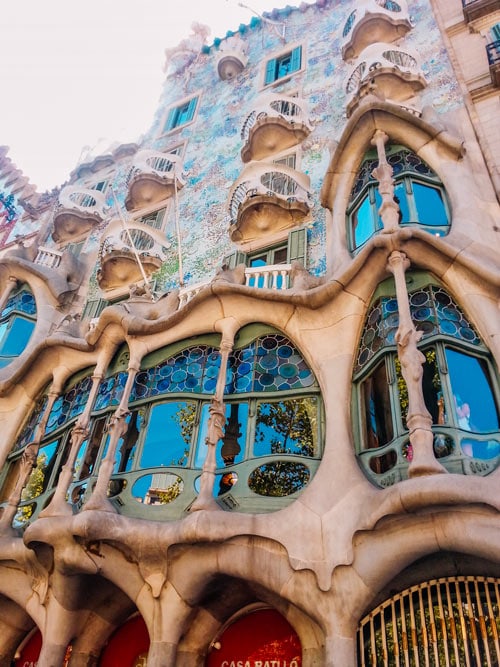
Old Town of Caceres
By Janis & Gary of Our World for You
The beautiful city of Cáceres in the Extremadura region of Spain was founded by the Romans in 25 BC, and it is truly a lovely place in Spain to stay for a couple of nights. The stunning walled Old City is encompassed by 30 towers constructed by the Moors during the 12th century.
I adore Moorish architecture, and in Cáceres, you really feel like you have strolled into another era of history. Weave your way through the narrow honey-colored lanes, and around every ancient corner, there’s a tale to be told.
Head to the Plaza de San Jorge and visit the Church of San Francisco Javier. This 18th-century Baroque-style church with its pink towers overlooks the Plaza.
I urge you to climb to the top of the belltower as the views across the terracotta rooftops of Cáceres are magnificent. Believe me, you won’t regret it!

Medina Azahara
A few km away from Cordoba’s old town, you’ll find the remains of Medina Azahara, a 10th-century city built for Abd-al Rahman III. He was a member of the Umayyad dynasty and founded the Caliphate of Cordoba.
Medina Azahara was the political center of that Caliphate and consisted of several luxurious palaces, a mosque, gardens, and more. It was only discovered at the beginning of the 20th century, and the excavations still take place today.
The visit to this magnificent UNESCO-listed landmark includes the archeological site, as well as a visitors center with exhibitions telling the history of the city while showcasing original pieces.
Plaza de EspañA, Seville
Considering all the things you can do and see in Seville, it might sound weird that a public square made me want to visit this city. But this is no ordinary square – this is a work of art and one of the prettiest squares in Europe.
Designed in 1928 for the Ibero-American Exposition of 1929, Plaza de España is a complex of pavilions, towers, bridges, and even a canal, all wrapped up in a colorful mix of architectural styles.
You can easily spend a few hours taking photos of it from every possible angle (like I did). So take your time to appreciate every single element, and pay extra attention to the tiled walls that represent Spain’s 48 provinces.

City of Arts and Sciences, Valencia
While most of this list includes historical monuments, this famous sight in Spain will make you feel like stepping into the future.
The City of Arts and Sciences is an astounding cultural complex covering 350,000 square meters and housing six amazing structures.
From the Oceanografic (Europe’s largest aquarium) to the Principe Felipe Science Museum to the open-air Umbracle, this complex is an ideal spot for an afternoon stroll.
Each museum has its own prices, but you can wander through this area for free.
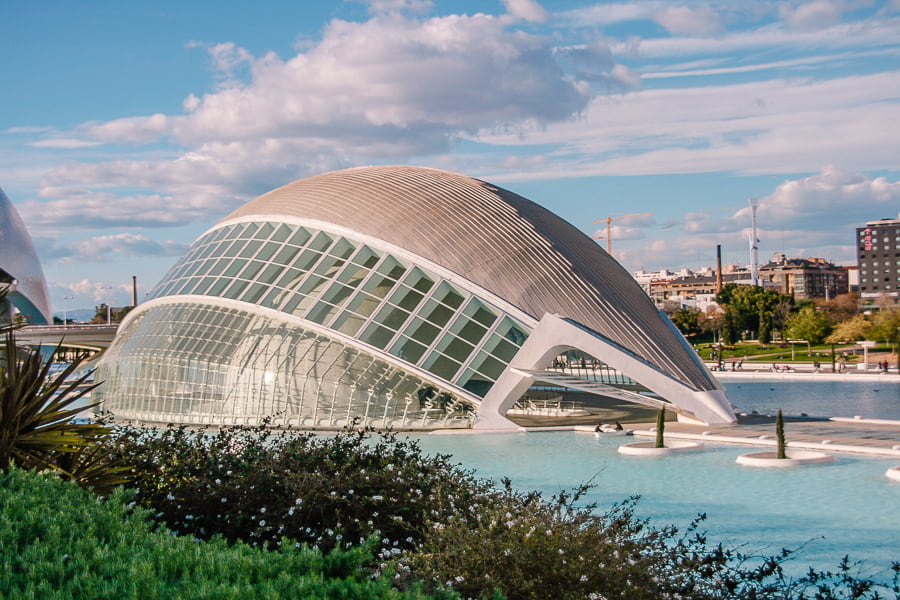
Silk Exchange, Valencia
One of the most significant landmarks in Valencia, the Silk Exchange (La Lonja de la Seda) is a beautiful 15th-century Gothic building. It was a commerce center mostly used for trading silk that had a big role in the prosperity of València at that time.
Stepping inside this fortress-like building, my favorite part of it was the Hall of Columns, a gorgeous room where the actual silk trading took place.
AQUEDUCT OF SEGOVIA
The Roman Aqueduct of Segovia is one of the first things you see when approaching the city center.
It takes a few minutes to take it all in and realize how tall and well-constructed it is, and it only becomes more impressive as you get closer to it.
Dating back to the 2nd century, it is one of the best-preserved elevated Roman aqueducts you’ll see, consisting of over 20,000 stone blocks and 167 arches.

Walls of Avila
The Walls of Avila are some of the best-preserved medieval walls in all of Europe!
Built in the 11th-12th centuries to protect the city from the Moors, they consist of more than 80 towers and 9 gates, including Puerta del Alcazar and Puerta de San Vicente.
The old town of Ávila (including the walls) and its extramural churches are listed as a UNESCO World Heritage Site. If you climb the walls, it is possible to walk along about half of their length (they’re 2.5-km long) and enjoy the views.
Puente Nuevo, Ronda
Without a doubt, Ronda is one of the best places to visit in Andalucia, and one of its most iconic sights is Puente Nuevo (New Bridge).
Built in the 18th century to join the two parts of Ronda separated by the El Tajo Gorge, it provides fantastic views of the gorge and the whitewashed houses sitting on the edge of the cliff.
To take the best photos of the bridge, you’ll find several scenic lookout points, including Mirador Puente Nuevo de Ronda and Mirador La Hoya Del Tajo.

Dalí Theatre-Museum, Figueres
By Rachel from Rachel’s Ruminations
If you’ve ever looked at a Salvador Dalí artwork and wondered what he was thinking, the Dalí Theatre-Museum in Figueres would be a great place to visit.
Called a theatre-museum because it was built on the ruins of a theater, the entire place, inside and out, was designed by Dalí himself. It’s filled with 1500 works: furniture, sculpture, installations, and, of course, paintings.
The first two spaces, in particular, are truly bizarre art installations. Even how the paintings are displayed is puzzling: early cubist and impressionist works mixed in with later surrealistic masterpieces.
Make sure to book your tickets ahead to avoid waiting in line. To learn more, read Dalí Theatre-Museum: A glimpse into Dalí’s mind.
El Capricho de Gaudi, Comillas
One of the few Gaudi creations outside Catalunya, El Capricho was built in the 19th century as a summer villa for a Spanish immigrant who returned to Spain after having made his fortune.
Knowing Gaudi’s creative style, you can expect a colorful building with unique decorative elements like sunflower tiles and stained glass windows. I also loved the garden and the hydrangeas (aka my favorite flower) surrounding the house.

Guggenheim Museum, Bilbao
One of my favorite things to see when I’m traveling is uniquely designed buildings, and the Guggenheim Museum in northern Spain did not disappoint.
Designed by architect Frank Gehry, the museum looks quirkily futuristic, and the huge sculptures of a metal spider and a flower-covered puppy near it are a fantastic extra touch.
Beyond its impressive exteriors, the museum is a great place to visit for contemporary art lovers.
Roman Theatre of Mérida
While you’ll find quite a few Roman landmarks in the city of Merida, its crowning glory has to be the UNESCO-listed Roman Theatre.
Dating back to 16-15 BC (incredible, right?), it was built under the patronage of the consul Vipsanius Agrippa in the Roman city of Emerita Augusta.
Today, not only is it a highly visited site, but it also hosts the annual International Classical Theatre Festival, taking place in summer.

Roman Amphitheater of Tarragona
Another must-see Roman ruin in Spain is the Amphitheatre of Tarragona in the region of Catalunya.
It was built in the early 2nd century for entertainment, hosting events like gladiator combats and chariot races, and was later used as a convent and a prison.
Fun fact: The city’s ancient name is Tarraco, which was the oldest Roman settlement on the Iberian Peninsula, so it’s more than a privilege to visit a landmark from that era.
Casas Colgadas of Cuenca
One of the biggest reasons to visit Cuenca is to see its Casas Colgadas (Hanging Houses).
While their origins are not entirely known (probably medieval), and while only a few of them are still standing today, you can’t miss seeing these unique houses literally built on the edge of a cliff.
One of them also houses the Museum of Spanish Abstract Art, boasting a collection of over 120 paintings.

Tower of Hercules, a Coruña
A Coruña is relatively overlooked when it comes to cities to visit in Spain, so you might be surprised to know that it’s home to a Roman lighthouse, which is one of the oldest functioning lighthouses in the world.
A few myths and legends have been told about the tower, one suggesting that this is where Hercules slew the giant Geryon, demanding to build a city on the site (hence the name of the lighthouse).
Palau de la Música Catalana, Barcelona
Nothing like any other concert hall you’ve ever seen, the Palau de la Música Catalana is a majestic modernist building in Barcelona and a UNESCO Site.
With a genius combo of sculptures, mosaics, a stained-glass skylight, and other decorative elements, it is a feast for the eyes on the inside and out.
To visit it, you can take a self-guided tour, book a guided tour, or get a ticket to one of the many concerts it hosts.
Read more about Spain:
- Hidden gems in Spain
- Long weekend holidays in Spain
- Best road trips in Spain
- Things to know before visiting Spain
- Novels set in Spain
- Spain themed gifts
- Spain travel quotes
- Travel quotes in Spanish with translation
Pin this list of the most famous Spanish landmarks for later using the share icon on the right bottom corner and check out my roundups of famous landmarks in Poland, Portugal, and Austria!


*Your emil address will not be published. By using this form you agree with the storage and handling of your data by this website